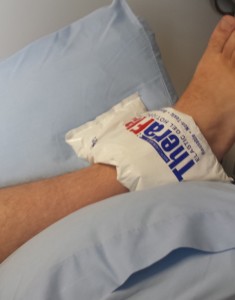With the World Cup upon us once more we will today take a look at a common injury which the players, or you, may encounter over the coming month and beyond.
Ankle sprains are one of the most common injuries in sport, especially football. In fact 2/3rds of footballers experience an ankle sprain during the course of their career.
These sprains mostly occur on the outside (or lateral aspect) of the ankle when rolling over the outside of the ankle. This movement is known as inversion and causes the ligaments that surround the outside of the ankle joint to become stretched.
It is a ligaments job to hold a joint together by lashing bones together. This gives a joint increased stability. When a ligament is stretched the stability of the joint it surrounds is decreased.
The severity of an ankle sprain will depend on how far the ligaments on the side of the ankle were stretched. Grade 1 sprains will involve a small stretching of the ligament. Grade 2 sprains will rupture a portion of the ligament, whilst a Grade 3 tear will completely rupture a ligament and may require a cast to be put in place. The recovery period from an ankle sprain will also depend on which grade of tear occurred.
Recovery
After the initial injury the ankle may begin to swell, if this is the case it is important that a player follow “POLICE” procedures for the 48-72 hours, POLICE stands for:

P- Protection, this involves the use of crutches, casts or braces as necessary during the healing process, this may be early on in the process when excessive weight bearing would be detrimental to recovery
OL- Optimal Loading; the weight that the athlete may place through their injured limb will depend on how damaged the ankle is, for example the optimal level of loading on a fractured ankle may be no weight bearing at all as casting is required. It may be necessary to seek advice from your Physiotherapist as to when you can start to weight bear through the injured limb as it can also be detrimental to your rehabilitation if you don’t start this stage soon enough.
I- Ice, ice should be applied to the ankle for 15 minutes every 2 hours, it is important that ice is not place directly on the skin as this may cause the skin to burn
C- Compression, the ankle should be compressed, this can be done using a bandage or tubagrip, compression can help reduce the potential swelling in the ankle
E- Elevation, the ankle should be elevated to decrease the swelling of the ankle
Following POLICE procedures can greatly reduce the swelling of the ankle and can allow the rehabilitation of the ankle to start sooner as a result. Once the swelling has settled it is important to undergo rehabilitation with a physiotherapist as there is a high chance of re-injury after an ankle sprain.
Physiotherapists can help reduce the pain in the ankle and reduce the likelihood of injuring the ankle again. This is done through a rehabilitation program that will improve the strength of the muscles around the ankle, increasing the flexibility and range of movement. We can then aim to improve the balance and proprioception of the athlete through the use of equipment such as the wobble board.
Even after rehabilitation it may be necessary for an athlete to tape or brace the ankle to prevent re-injury.

